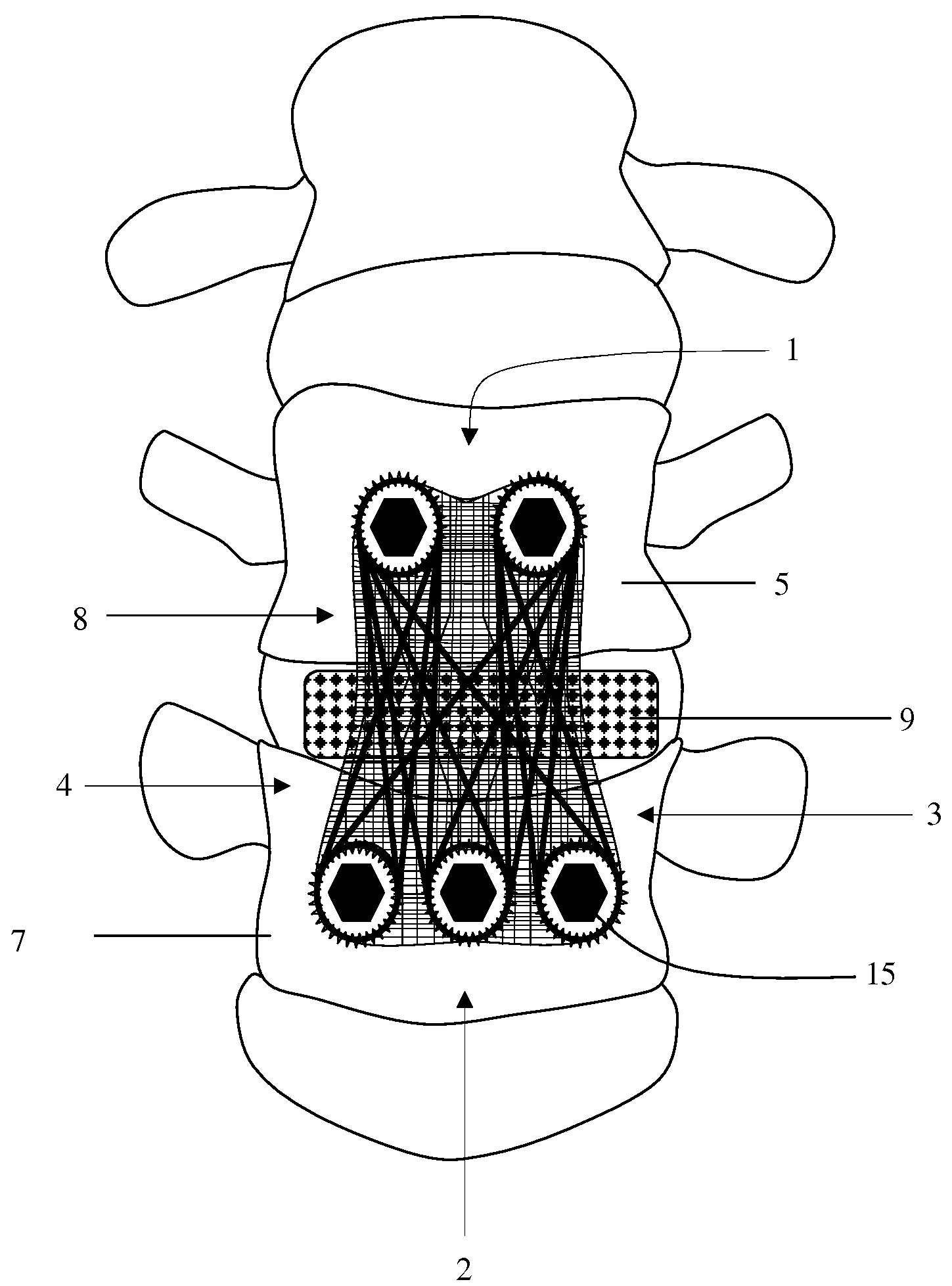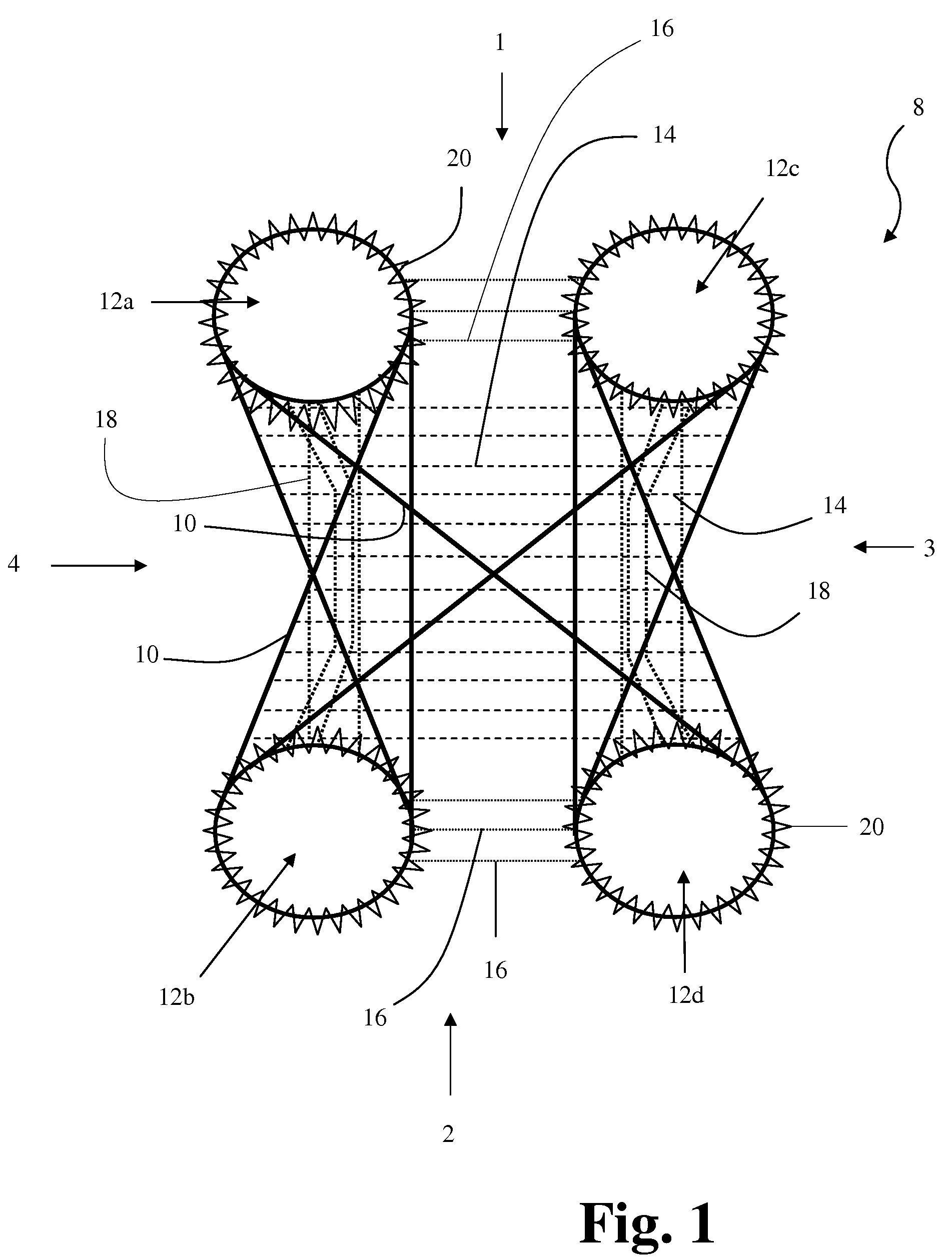Textile-Based Plate Implant and Related Methods
- Summary
- Abstract
- Description
- Claims
- Application Information
AI Technical Summary
Benefits of technology
Problems solved by technology
Method used
Image
Examples
first embodiment
[0088]FIG. 1 illustrates an example of a textile-based plate implant 8 according to the present invention. The implant 8 is suitable for posterior, lateral or anterior insertion within the lumbar, thoracic or cervical regions of the spine. In the interest of clarity, each of the below elements are illustrated within FIG. 1 with a line quality common to that element type. Therefore, the use of dotted lines in this and other illustrations within the present application is not intended to denote various views generally attributed to the use of such lines, but rather are meant to indicate different stitching types. The implant 8 generally comprises a lattice work of filaments including load bearing filaments 10, horizontal reinforcement filaments 14, inter-aperture support filaments 16, longitudinal reinforcement filaments 18, and aperture reinforcement filaments 20, which together define the dimensions of the implant 8 including apertures 12a-12d.
[0089]The implant may be constructed f...
third embodiment
[0124]FIG. 18 illustrates the present invention comprising a generally planar textile based plate 8 with four sides 1-4 dimensioned to preferentially align five fixation apertures 12a, 12b, 12c, 12d, 12e with the intended receiving tissues 5, 7 (FIG. 19) for insertion within the lumbar, thoracic and cervical regions of the spine. In the interest of clarity, each of the below elements are illustrated within FIG. 18 with a line quality common to that element type. Therefore, the use of dotted lines in this and other illustrations within the present application is not intended to denote various views generally attributed to the use of such lines. The present device comprises a lattice work of filaments including load bearing filaments 10, horizontal reinforcement filaments 14, inter aperture support filaments 16, longitudinal reinforcement filaments 18, aperture reinforcement filaments 20 and a border filament 24 which together define the dimensions of the apertures 12a, 12b, 12c, 12d,...
second embodiment
[0156]Although shown and described in FIGS. 28 & 29, as creating a bi-modic tension feature in an embroidered structure 26 through the use of a combination of straight and zigzag load bearing filaments 50-56 and 60-62, a variety of techniques may be used to achieve the effect of a multi-modic tension feature. By way of example only, as shown in FIGS. 30-35, thread paths 112 of long stitches 114 and thread paths 116 of short stitches 118 may be used to create the effect of a multi-modic tension feature in an embroidered structure 110, according to the present invention.
[0157]FIG. 30 illustrates a backing thread 120 and a stitching thread 122 stitched together on a dissolvable substrate 124. The threads 120, 122 may be formed from any suitable material for creating an embroidered structure, including but not limited to polyester, polypropylene, polyethylene, ultra high molecular weight polyethylene (UHMWPe), carbon fiber, glass, glass fiber, polyaramide, metal, copolymers, polyketones...
PUM
 Login to View More
Login to View More Abstract
Description
Claims
Application Information
 Login to View More
Login to View More - R&D
- Intellectual Property
- Life Sciences
- Materials
- Tech Scout
- Unparalleled Data Quality
- Higher Quality Content
- 60% Fewer Hallucinations
Browse by: Latest US Patents, China's latest patents, Technical Efficacy Thesaurus, Application Domain, Technology Topic, Popular Technical Reports.
© 2025 PatSnap. All rights reserved.Legal|Privacy policy|Modern Slavery Act Transparency Statement|Sitemap|About US| Contact US: help@patsnap.com



